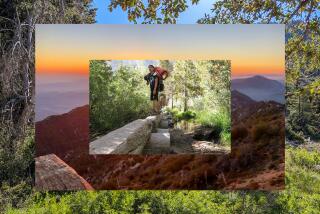New Monrovia Trail Clears Path to Mountain’s Pristine Heart
For 50 years, the ancient oaks, rushing streams and thick chaparral above Sawpit and Monrovia canyons have been inaccessible to nature lovers.
Mountain lions, bobcats, golden eagles, deer, owl, quail and coyote are plentiful. Bear marks are visible on wooden utility poles. “It’s one of the lushest areas of the San Gabriel Mountains,” said naturalist and author Elna Bakker.
For nine months, 200 volunteers braved poison ivy, sunburn and rattlesnakes; hacked through thick underbrush, and pushed aside large boulders to carve a trail across canyon bottoms and ridge tops in this pristine area on the edge of Angeles National Forest.
The resulting 2.5-mile Ben Overturff Trail, overlooking Monrovia in the San Gabriel Valley, opened Saturday to hikers; portions are also open to mountain bikers and horseback riders. The trail, which connects to a network of roads and other trails, allows access to the remote heart of the mountains.
At a time when budget cuts hamper trail maintenance and the creation of new ones, and when development eats away at open space, outdoor enthusiasts say the footpath represents a breath of fresh mountain air inSouthern California.
“It was a sin that nobody was allowed up here for 50 years,” volunteer trail organizer Glen Owens said, surveying the landscape.
George Hills, Monrovia’s parks superintendent who oversaw the project, said: “It is good for society to be able to come here and learn to appreciate nature.”
As he hiked the untrammeled canyon bottoms and ridge tops, Hills said: “If I told you I wasn’t nervous about letting lots of people up in here, I’d be lying.”
But Bill Cull, a member of the Monrovia committee that oversaw a $50,000 state grant to build the trail, said “rather than keep it locked up as a treasure trove accessible to only a few, we decided to let everyone in.”
The grant was supplied by environmental funds from fees on personalized license plates.
Building the trail was no easy task, although most of it traverses an old pack train route that ranged from 1,300 to about 3,200 feet above sea level.
Even before the teams of volunteers could be brought to work, Hills and Cull had to rough out the path.
“Everything was so overgrown, the brush so thick,” said Cull, 72, a retired electrical contractor. “We’d try to cut toward each other. We’d crawl up on (the brush) or crawl on our belly under and then we’d stick a flag up and wave it, get the alignment and start cutting.
“You try to go with the general contour of the slope so you don’t have any abrupt changes” that might provoke erosion, he said.
During the first half of the century, city dwellers had access to the canyon area, using a trail made by Monrovia contractor Ben Overturff. After falling in love with the area at the turn of the century, Overturff built a small stone getaway lodge, Deer Park Cabin, on Forest Service land bordering the city.
Overturff was known for regularly parading a pack train of burros through Monrovia on the way up to the cabin, where his wife baked lemon pies that lured guests up the mountain. But after a flood damaged the resort in 1938 and Overturff became ill a few years later, the resort closed.
Eventually, the county and Monrovia shut down access to the trail to safeguard the area around Sawpit Dam.
In contrast with other mountain recreation areas of Southern California, the canyons are surprisingly pristine.
“There is some fear that opening this trail will subject the area to graffiti and vandalism,” Hills said. But he said volunteers “are going to police the litter and teach people to appreciate nature.”
A rich diversity of plant and animal life abounds there and for decades the area has been untouched by heavy damage from the twin furies of the San Gabriel Mountains: fire and flood.
Monrovia officials hope that there will be an added benefit.
To ensure that development would not be allowed to encroach on the wilderness, the city hopes to sell 1,200 acres to a land conservancy, which would donate it to the federal government. The cash-strapped city, which can ill afford to give away the land, would receive at least $648,000.
“It really is a significant piece of land,” said Scott Parker, project manager for the Trust for Public Land, the nonprofit group that would buy the land. “I’m amazed at it.”
* GOOD TRAIL NEWS: Overturff’s opening ends a bad year for trail lovers. L16
More to Read
Sign up for The Wild
We’ll help you find the best places to hike, bike and run, as well as the perfect silent spots for meditation and yoga.
You may occasionally receive promotional content from the Los Angeles Times.






